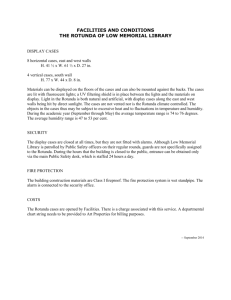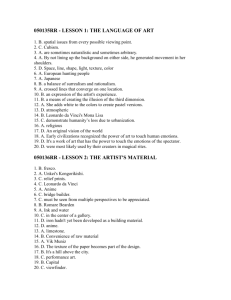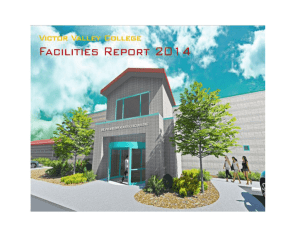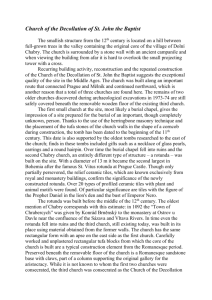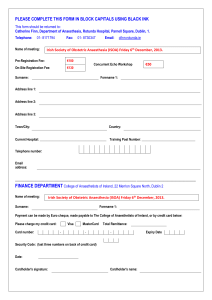Ecological Design or Some Aspects to the Reconstruction of a Mediaeval Rotunda
advertisement
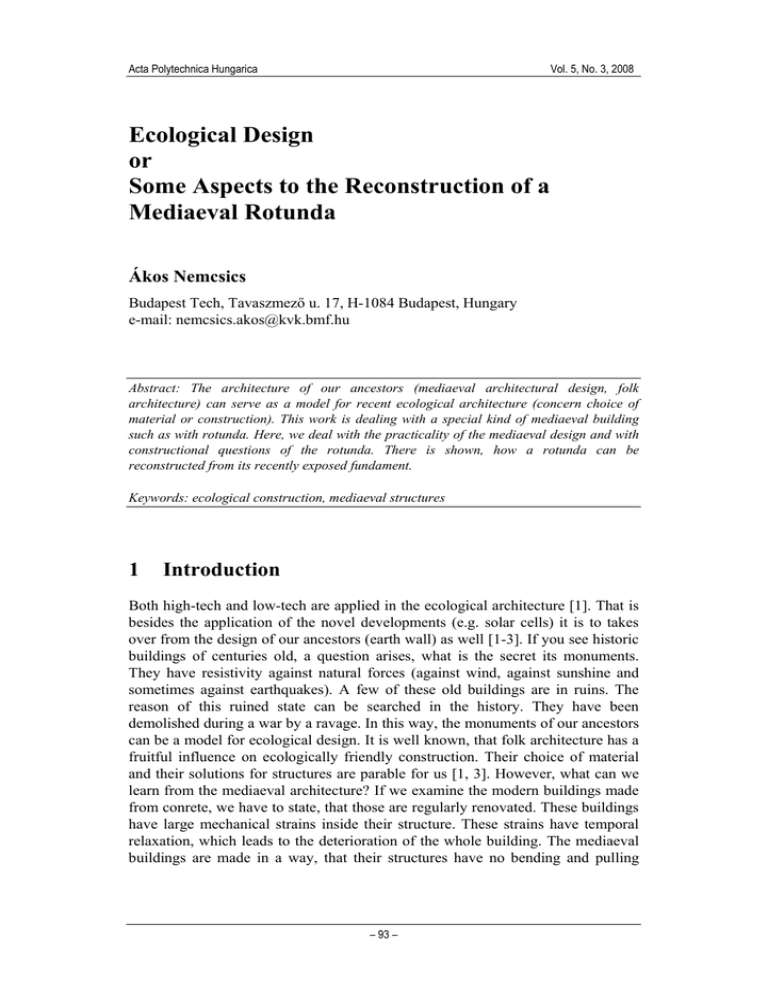
Acta Polytechnica Hungarica Vol. 5, No. 3, 2008 Ecological Design or Some Aspects to the Reconstruction of a Mediaeval Rotunda Ákos Nemcsics Budapest Tech, Tavaszmező u. 17, H-1084 Budapest, Hungary e-mail: nemcsics.akos@kvk.bmf.hu Abstract: The architecture of our ancestors (mediaeval architectural design, folk architecture) can serve as a model for recent ecological architecture (concern choice of material or construction). This work is dealing with a special kind of mediaeval building such as with rotunda. Here, we deal with the practicality of the mediaeval design and with constructional questions of the rotunda. There is shown, how a rotunda can be reconstructed from its recently exposed fundament. Keywords: ecological construction, mediaeval structures 1 Introduction Both high-tech and low-tech are applied in the ecological architecture [1]. That is besides the application of the novel developments (e.g. solar cells) it is to takes over from the design of our ancestors (earth wall) as well [1-3]. If you see historic buildings of centuries old, a question arises, what is the secret its monuments. They have resistivity against natural forces (against wind, against sunshine and sometimes against earthquakes). A few of these old buildings are in ruins. The reason of this ruined state can be searched in the history. They have been demolished during a war by a ravage. In this way, the monuments of our ancestors can be a model for ecological design. It is well known, that folk architecture has a fruitful influence on ecologically friendly construction. Their choice of material and their solutions for structures are parable for us [1, 3]. However, what can we learn from the mediaeval architecture? If we examine the modern buildings made from conrete, we have to state, that those are regularly renovated. These buildings have large mechanical strains inside their structure. These strains have temporal relaxation, which leads to the deterioration of the whole building. The mediaeval buildings are made in a way, that their structures have no bending and pulling – 93 – Á. Nemcsics Ecological Design or Some Aspects to the Reconstruction of a Mediaeval Rotunda forces. So here, the above mentioned relaxation does not apply. The walls and the bridging are constructed so, that only the compressive force is produced in the material, which can tolerate it. The rotunda presented here is a good model for demonstrating the above mentioned principle. In this work is shown, the reconstruction of a rotunda from the fundament. This reconstruction demonstrates the practicality of the mediaeval architectural culture. Figure 1 Illustration of the Alberti- (A) und Blondel-low (B) 2 Some Aspects to the Mediaeval Rotunds The rotunda is a specular kind of our mediaeval sacred architecture. There are many rotunds in Carpatian basin. Some of them have not remained in their original form. Several ones were built in a larger church e.g. as a choir. Others were demolished and only its fundament remained. There are turn-symetrical churches in varous places in Europe. But according to the archeological excavations, we can declare that its denity is larger in Carpatian basin [4, 5]. These turn-symetrical rotunds possess frequently arched and rarely angled choirs. These rotunds in our territory differ from the West European ones not only in structure but in dimension as well [5, 6]. The internal diameter of our rotunds range between 5 and 7.5 m [4, 5]. Because of the frequent occurrence of our rotunds, their origins may not root in the West European or Byzantine model [5]. Instead of taking over, the origin of these rotunds have to be searched in the expedient constructional technology. The oldest rotunds in our territory are made from sticked-wicker-work, which is proved by excavations. Our ancestors have also rounded houses. Hence, we can declare that the frequency of these circular buildings originate in the technology and constructional experience of our ancestors. – 94 – Acta Polytechnica Hungarica Vol. 5, No. 3, 2008 Figure 2 Demonstration of the role of kneewall and of the fill of vaultback 3 Mediaeval Engineering For the reconstruction, we have to know the mediaeval mathematical and scientific culture [7]. We have few written documents from this mediaeval technical culture. The vaulted small churches and the large cathedrals serve as an essential fact to discover this knowledgement. The remained delineations in codices contain information about the execution of the cathedral [9-12]. In this work, we focus on the data which are connected with the rotunds. The architecture of our ancestors is always shoped by practicability [1-3]. This practicability or ecologicality help us find the proper construction. The bridging over the room determines fundamentally the dimension of the building. The bridging, that is the covering of the mediaeval rooms, can be either flat ceiling or vault. The square naves and choirs can be both kinds such as flat ceiling or vault. The arched choirs have always vault. In consequence of the construction, the vault is practical in the case of rotunds. The supporting forces of the vault (span) and their revetment wall (height and width) determine the enclose dimensions of the building. We have to be aware of the mediaeval planning methods and intact rotunds for the reconstruction of our building. It is to be noted that, the planning rules are the – 95 – Á. Nemcsics Ecological Design or Some Aspects to the Reconstruction of a Mediaeval Rotunda same for both the two and three dimensional (that is turn-symmetrical) vaults. Two dimensional vault is e.g. the triumphal arch of the choir and three dimensional one is e.g. the dome of the nave of the rotunda. The dome can be a real or a quasi cupola, which have theoretically different static functions. In practice, the real and the quasi cupola has not only formal similarity, but because of the friction between the large stones, their functions is partly also similar. Figure 3 Groundplan of the reconstructed rotunda There are documents from the Middle Ages and from the Renaissance about the ancient planning rules. One of them is written by L. B. Alberti. This rule gives the relation between span (D), high and width of the pillar (Fig. 1A). The width of pillar (d1) has to be about quarter of the span (d1 ~ D/4). When the hight of construction (H) increases, then the width of the pillar increases, too. Here, the relation is also the function of the quarter (d1 = H/4). The thickness of the vault (d2) has to be the tenth of the span (d2 ≥ D/10). Another rule was descibed by F. Blondel (Fig. 1B). This rule values when the hight is not larger than one and a half times of the span (H1 ≤ 1.5×D). The calculation of the pillar width can be followed in figure (d1 = (D-a)/2). These rules describe well the dimension of the small diameter rotunds (D ~ 5 m). There are different planning rules for the larger diameter buildings [13-15]. It is important to avoid the stability loss of the cupola. Fig. 2 demonstrates the role of kneewall and that of the fill of vaultback [5]. – 96 – Acta Polytechnica Hungarica Vol. 5, No. 3, 2008 Figure 4 Cross section of the reconstructed rotunda 4 The Reconstruction of the Rotunda Our knowledge about the rotunds is increasing because of the excavations which have beenmade recently, too. The excavated rotunda discovered recently serves as a base for this work [16]. Here, not only the fundaments of the rotunda but many graves and other things have been opened up. The data of the fundament are the following: the diameter of the nave (DH = 5 m), the diameter of the choir (DA = 2.4 m), the thickness of the walls (d1H = 1.2 m, d1A = 0.8 m). The ground-plan of the rotunda is derived from the meaurement of the fundament (Fig. 3). The hight of the nave wall and the choir wall can be determined with the help of the planning rules and with the proportions of intact rotunds. We can suppose the standardization in the measurement of the rotunda contruction because this building type was very often built in this region. (We can observe similar standardization in the case of folk arhitcture or in construction of family houses.) The ground-plan of the rotunda is derived from the measurement of the fundament (Fig. 3). The standardizatio often means oversized structures. The hight of the walls were detremined iteratively manner. The cross-section of the rotunda can be shown in Fig. 4. It is to be noted that some stones of the windows were founded, – 97 – Á. Nemcsics Ecological Design or Some Aspects to the Reconstruction of a Mediaeval Rotunda which could also help at determination of the vault position [5]. Some trimmed stones were discovered, they have a curved side. The curved side has two different radii which enable the dome of the nave to be quasi cupola (Fig. 5) [5]. Figure 5 Stones in the quasi-vault Acknowlegdements First of all, the author would like to thank to his former and present students for the interest and enthusiasm in this topic. Without them, the experimental part of this project would not have been realized. The author is indebted to Sándor Petényi, that he has made the unpublished excavation protocol of the rotunda available. References [1] Nemcsics, Ákos: Ecological Construction; text book KKMF-1184 Budapest (1999) (in Hungarian) [2] Nemcsics, Ákos: Earth House with Utilization of Solar Energy; Proc. of EuroSun Conference, 14th International Sonnenforum (20-23 June 2004, Freiburg, Germany Band 2 pp. 831-834 [3] Nemcsics, Ákos: Ecological Architecture on the Basis of Mediaeval Samples (in Hungarian); Öko Házak Magazin 2007/3, pp. 30-32 [4] Gervers-Molnár, Vera: The Rotunds of Mediaeval Hungary (in Hungarian); Művészettörténeti füzetek 4; Akadémiai Kiadó, Budapest, 1972 [5] Nemcsics Ákos: Thoughts Concerning of the Reconstruction of a Mediaeval Rotunda; (In Hungarian); Építés- Építészettudomány (2008) Vol. 36, No. 1-2, pp. 43-65 [6] Untermann, Matthias: Der Zentralbau im Mittelalter; Wissenschaftliche Buchgesellschaft, Darmstadt (1989) – 98 – Acta Polytechnica Hungarica Vol. 5, No. 3, 2008 [7] Simonyi, Károly: Kulturgeschichte der Physik; Verlag Harri Deutsch, Frankfurt am Main (1990) [8] Binding, Günther: Baubetrieb im Buchgesellschaft, Darmstadt (1993) [9] Kottmann, Albrecht: Das Geheimnis romanischer Bauten; Julius Hoffmann Verlag, Stuttgart (1971) [10] Cali, Francois: Das Gesetz der Gotik; Prestel Verlag, München (1963) [11] Bandmann, Günter: Die Bauformen des Mittelalters; Athenäum-Verlag, Bonn (1949) [12] Cowan, Henry: The Master Builders; Malabar, Robert Krieger Publishing Comp. (1977) [13] Bütter, O., Hampe, E: Bauwerk, Tragewerk, Tragstruktur, Berlin VEB Verlag für Bauwesen (1977) [14] Mainstone, Rowland: Developments in Structural Form, London, Allen Lane (1975) [15] Baker, I: A Treatise on Masonry Construction, New York, John Wiley & Sons (1989) [16] Petényi, Sándor: Protocol of the Excavation (in Hungarian, unpublished) – 99 – Mittelalter; Wissenschaftliche
